This green house is nestled in the English countryside
Ashraya, a low carbon, green house designed by Kirkland Fraser Moor, sits within the rolling hills of The Chilterns

This green house in the English countryside is designed almost like an underground home, nestled low within its leafy environs and under a roof planted with an enticing meadow. Welcome to Ashraya, a residence designed by British architecture practice Kirkland Fraser Moor, and conceived as an innovative example of sustainable architecture; but also a comfortable and expansive contemporary home.
Located among the rolling green hills of The Chilterns Area of Outstanding Natural Beauty (AONB), the house was designed to respect its surroundings. The planted, arching roof mimics the landscape and feels a natural addition to the site, which connects with a historic English walled garden behind a long, historic flint wall. Two round courtyards, one at the front and one at the back of the house, create further links to the architectural gardens beyond.
The discreet exterior conceals a generous residence spanning three levels. Built according to Paragraph 80 of the National Planning Policy Framework, which permits ‘construction of stand-alone rural houses if the design is of exceptional quality’, Ashraya is certainly eye-catching. Still, the building remains low and minimally visible from the street and neighbouring properties.
Green house with low carbon solutions
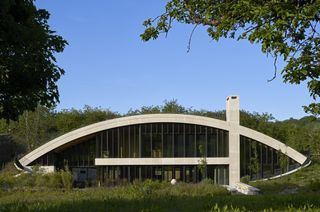
An expansive sunken ground level contains the open-plan living areas, under the exposed timber roof. Bedrooms upstairs are complemented by a basement level that features a studio, a snooker room and an alternative circulation method: a slide that playfully connects the stairs and a den.
As far as eco-credentials go, this green house can boast a number of sustainable measures. A ground source heat pump system helps warm up the space, while the cooling system is an innovative low carbon solution that makes use of 90m-deep boreholes. Straw, clay, chalk and natural lime were used for the creation of blocks that make up most of the walls. Extensive use of natural materials further helps connect the house to nature.
‘Ashraya is a unique piece of rural architecture that is harmoniously in balance with its surrounding landscape and ecology. It continues and enhances the strong regional vernacular tradition without resorting to pastiche,' says Kirkland Fraser Moor founding partner David Kirkland. ‘Ashraya has been five years in the making, during which time there were many hurdles to cross: dealing with sensitive planning issues and pushing the limits of construction and low carbon technology. It is an exemplar of a dwelling that captures the full ambition of Paragraph 80 and the clients hope that in future years it will be recognised as a valuable contribution to the local architectural heritage.'

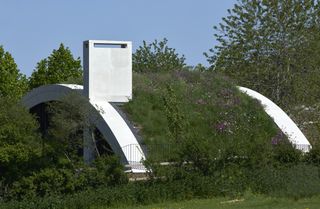
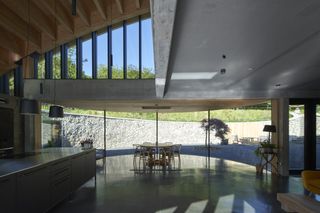
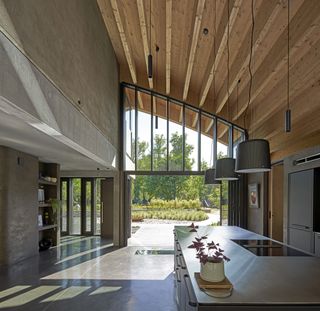




INFORMATION
Wallpaper* Newsletter
Receive our daily digest of inspiration, escapism and design stories from around the world direct to your inbox.
Ellie Stathaki is the Architecture & Environment Director at Wallpaper*. She trained as an architect at the Aristotle University of Thessaloniki in Greece and studied architectural history at the Bartlett in London. Now an established journalist, she has been a member of the Wallpaper* team since 2006, visiting buildings across the globe and interviewing leading architects such as Tadao Ando and Rem Koolhaas. Ellie has also taken part in judging panels, moderated events, curated shows and contributed in books, such as The Contemporary House (Thames & Hudson, 2018), Glenn Sestig Architecture Diary (2020) and House London (2022).
-
 The best design-led cocktail shakers
The best design-led cocktail shakersIf you like your drinks shaken not stirred, these are the best cocktail shakers to take your mixology skills to the next level
By Rosie Conroy Published
-
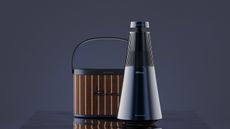 Tech Editor, Jonathan Bell, selects six new and notable Bluetooth speaker designs, big, small and illuminating
Tech Editor, Jonathan Bell, selects six new and notable Bluetooth speaker designs, big, small and illuminatingThese six wireless speakers signal new creative partnerships and innovative tech approaches in a variety of scales and styles
By Jonathan Bell Published
-
 As London’s V&A spotlights Mughal-era design, Santi Jewels tells of its enduring relevance
As London’s V&A spotlights Mughal-era design, Santi Jewels tells of its enduring relevance‘The Great Mughals: Art, Architecture and Opulence’ is about to open at London’s V&A. Here, Mughal jewellery expert and Santi Jewels founder Krishna Choudhary tells us of the influence the dynasty holds today
By Hannah Silver Published
-
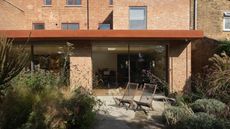 A Peckham house design unlocks a spatial puzzle in south London
A Peckham house design unlocks a spatial puzzle in south LondonAudacious details, subtle colours and a product designer for a client make this Peckham house conversion a unique spatial experience
By Jonathan Bell Published
-
 Squire & Partners' radical restructure: 'There are a lot of different ways up the firm to partnership'
Squire & Partners' radical restructure: 'There are a lot of different ways up the firm to partnership'Squire & Partners announces a radical restructure; we talk to the late founder Michael Squire's son, senior partner Henry Squire, about the practice's new senior leadership group, its next steps and how architecture can move on from 'single leader culture'
By Ellie Stathaki Published
-
 Meet the 2024 Royal Academy Dorfman Prize winner: Livyj Bereh from Ukraine
Meet the 2024 Royal Academy Dorfman Prize winner: Livyj Bereh from UkraineThe 2024 Royal Academy Dorfman Prize winner has been crowned: congratulations to architecture collective Livyj Bereh from Ukraine, praised for its rebuilding efforts during the ongoing war in the country
By Ellie Stathaki Published
-
 RIBA House of the Year 2024: browse the shortlist and pick your favourite
RIBA House of the Year 2024: browse the shortlist and pick your favouriteThe RIBA House of the Year 2024 shortlist is out, celebrating homes across the UK: it's time to place your bets. Which will win the top gong?
By Ellie Stathaki Published
-
 The new Canada Water boardwalk is an experience designed to ‘unfold slowly’
The new Canada Water boardwalk is an experience designed to ‘unfold slowly’A new Canada Water bridge by Asif Khan acts as a feature boardwalk for the London area's town centre, currently under development, embracing nature and wildlife along the way
By Ellie Stathaki Published
-
 Paddington Square transforms its patch of central London with its 'elevated cube'
Paddington Square transforms its patch of central London with its 'elevated cube'Paddington Square by Renzo Piano Building Workshop has been completed, elevating a busy London site through sustainability, modern workspace and a plaza
By Ellie Stathaki Published
-
 Architectural car parks to drive into, in the UK and beyond
Architectural car parks to drive into, in the UK and beyondArchitectural car parks form an important part of urban infrastructure but can provide a design statement too; here are some of the finest examples to peruse, in the UK and beyond
By Ellie Stathaki Published
-
 Architectural Association's newest show uncovers the architectural legacies of rural China's lost generation
Architectural Association's newest show uncovers the architectural legacies of rural China's lost generationThe Architectural Association’s ‘Ripple Ripple Rippling’ is not your typical architecture show, taking an anthropological look at the flux between rural and urban, and bringing a part of China to Bedford Square in London
By Teshome Douglas-Campbell Published